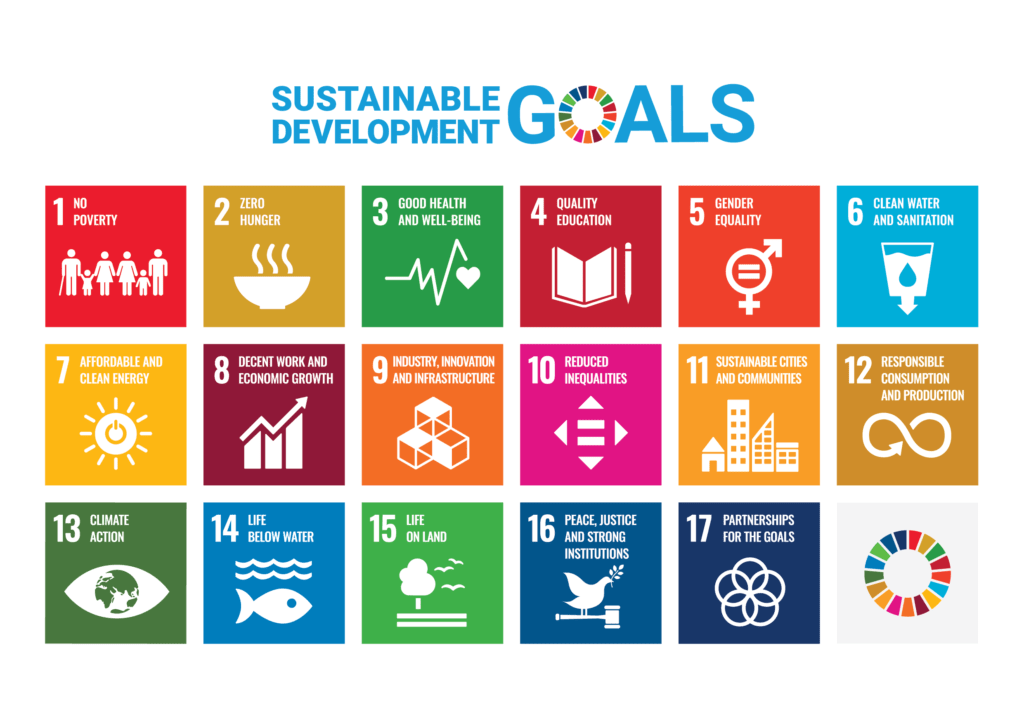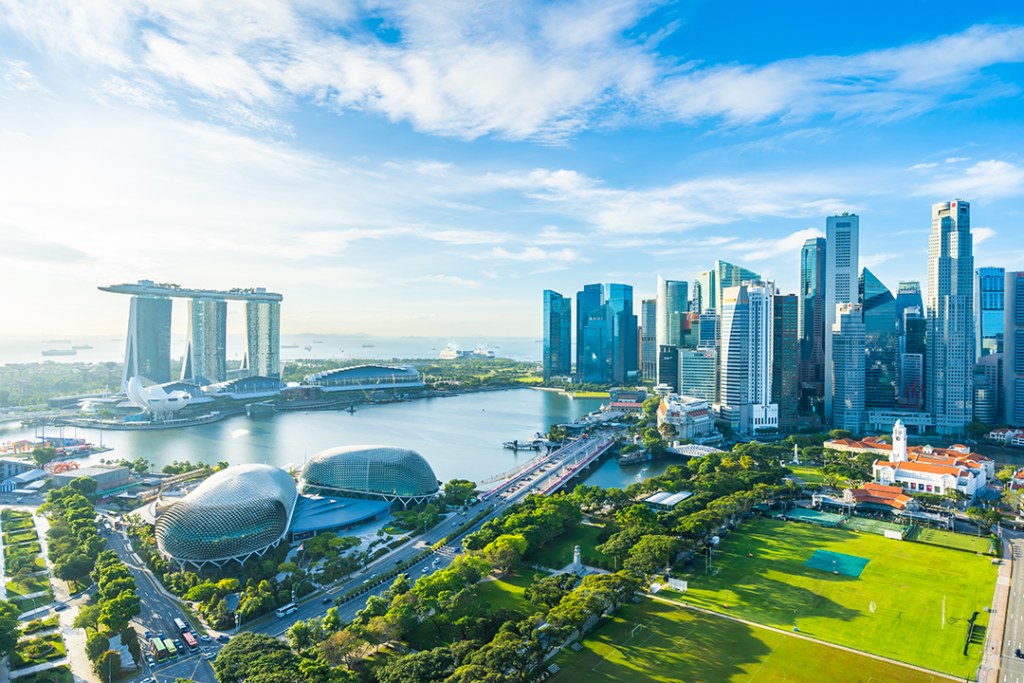The Singapore Green Plan 2030 was announced on February 10th, 2021 and is a comprehensive climate action plan that aims to accelerate the city-state’s green transition. It sets out ambitious and concrete targets to be achieved in the coming ten years, spearheaded by various government ministries such as the Ministries of Education, National Development, Sustainability and the Environment, Trade and Industry, and Transport. The plan improves upon Singapore’s environmental commitments under the United Nations’ 2030 Sustainable Development Agenda and the Paris Agreement, signed by 195 countries in 2016.

The 17 sustainable development goals (SDGs) adopted by all United Nations Members in 2015.
The plan has been called a “whole-of-nation movement to advance Singapore’s national agenda on sustainable development” and outlines a variety of new initiatives. Some of those initiatives include requiring new vehicles to satisfy more onerous emissions restrictions, doubling the targeted number of electric vehicle charging points in the city by 2030, and reducing the amount of waste being sent to landfill by 20% by 2026.
Other Key Targets of the Singapore Green Plan
Other key targets outlined in the plan include:
- developing more than 130 hectares of new parks and enhance 170 hectares of existing parks
- greening 80% of all buildings by 2030
- ceasing new registrations of diesel cars and taxis by 2025
- installing 60,000 vehicle charging stations nationwide by 2030
- planting 1 million more trees
- increasing the share of trips taken on mass public transport to 75% by 2030
- phasing out refrigeration and air-conditioning equipment using high global warming potential refrigerants by the end of 2022
- implementing the Enterprise Sustainability Programme to help enterprises embrace sustainability
- becoming a Green Finance leader in Asia and globally
- promoting homegrown innovation through the Research and Innovation & Enterprise Plan 2025

Highlights from the Singapore Green Plan 2030 as the city-state adopts and implements a national sustainability strategy over the next decade.
The financial case for sustainability
Sustainability, more generally, is cited in the Green Plan as a cause that will become Singapore’s “new engine” for jobs creation and economic growth. The government emphasizes the importance of the development of sustainable tourism and of incentivizing companies large and small to adopt more sustainable practices, solutions, and standards.
The Singapore Green Plan places particular emphasis on developing Singapore as a future authority in Green Finance and it is perhaps here that the Green Plan bears its teeth. Given that the financial sector globally holds such immense potential to pressure current emitters into adjusting their practices to reduce the negative environmental impacts of their activities, this focus of the Green Plan seems prudent and forward-thinking.
The trend seems to be getting more traction with investors as well. “Climate change may still be a matter of debate for some politicians, but investors are increasingly decisive.” As increasing amounts of money flows into Green Finance and as growing numbers of private citizens and investors demand that their cash goes towards green causes, Singapore is smart to start formally recognizing and supporting the development of their Green Finance sector.
“By building up the financial sector’s resilience to environmental risks, developing green financial solutions, building knowledge and capabilities, and leveraging innovation and technology, the Green Plan seeks to establish Singapore as a leading centre for green finance.” Green Finance not only has the potential to enable small populations to have an outsized and positive impact on the global push towards emissions reductions, but it also provides a very safe and reliable avenue for economic growth. Undoubtedly, early adopters will be rewarded by specializing in disciplines that we all know will only become more and more dominant in the coming decades. However, the question of what constitutes green and what constitutes green enough remains and could be a constant thorn in the side of Green Finance for the foreseeable future.
The human element
An interesting aspect of the plan is the “Green Plan Conversations.” Planned to take place throughout 2021, these conversations will give Singaporeans an opportunity to share their thoughts on the plan as it stands today. In fact, the plan actually describes measures that will be put into place to promote and monitor the development and advancement of “Green Citizenry” — essentially the combination of attitudes and behaviours that would lead to Singaporeans consuming in more environmentally friendly ways. This sort of stakeholder engagement should help ensure that the communities impacted by the plan are aware of and engaged with the plan from the very beginning. These conversations should also provide government representatives with a chance to explore potential partnerships in connection with the plan.
Why Singapore?
As a sovereign island located at the southern tip of the Malay Peninsula, this country of nearly 6 million people occupies an area of just 728 square kilometres – slightly larger than the area occupied by Greater Victoria on the southern tip of Vancouver Island. So what is it about Singapore that makes the city-state approach a green transition with such enthusiasm? And why is Singapore aiming above and beyond the targets they already set out in the Paris Agreement? To get an insider’s insight, we spoke with our in-market advisor in Singapore, Tuck Wai Lee.

A city in nature, green government, sustainable living, an energy reset, the green economy, and a resilient future are all key pillars of the Singapore Green Plan 2030.
What do you think of the Singapore Green Plan?
“The Green Plan is another positive step forward for Singapore on our sustainability journey. It builds on years of work in water resilience, resource efficiency, and building a city in nature. The Green Plan truly blends all these areas and establishes real and specific targets for individual sectors, which will be key to getting government and industry onside.”
What are people in Singapore saying about the Green Plan?
“Singaporeans have been responding really positively to the Green Plan. We’ve seen an increase in business activities to take advantage of the newfound clarity created by the Green Plan in terms of how the government aims to direct development and funding moving forward. There has also been a new swell of community activities aimed at generating support in the wider public, which is exciting to see. I think there are lots of industry players, especially in cleantech, who would like for the government to push even harder on sustainability, but there seems to be a general consensus that we’re moving in the right direction. And honestly, no one anywhere can move fast enough on sustainability so I think this is to be expected.”
What do you think is most exciting about the plan?
“I think the most exciting thing is seeing a real surge in innovative solutions and technologies in the cleantech space as companies based in Singapore ramp up their activities and establish really promising relationships with partners overseas. It’ll be an interesting space to watch in the next couple of years!”
How do you think this plan matters on a global scale?
“Singapore is still a small city-state, but I’m convinced that the Green Plan has global relevance. Firstly, it signals that small countries and even cities like ours know that we can be very vulnerable to the impacts of climate change and have to therefore contribute to the conversation through real action. And secondly, Singapore has a lot of experience with test-bedding technologies and we’re lucky to have a really healthy business environment for new ventures to develop and grow across the rest of Asia, with Singapore as the launchpad. So I think it ultimately showcases how much a relatively small population and area can accelerate the pace of change and adoption of green policies.”
What do you think the Singapore Green Plan means for Canadian cleantech companies?
“The Singapore Green Plan reinforces a business environment that has always been open to technology transfer and partnerships across international lines. With such specific targets and with a real sense of purpose here around cleantech, Canadian cleantech companies that are eyeing an expansion into the rapidly growing Asia markets should consider taking advantage of the momentum here. It just takes one quick conversation to get the ball rolling and start exploring potential partnerships and market entry in Singapore and beyond.”
What are your concerns about the Singapore Green Plan? Or where do you think it falls short?
“Quite honestly, I really don’t have any major concerns about the Green Plan as it stands now. As I said before, there is always more we can do, but this plan really does make some pretty major strides. I definitely hope that the various infrastructure initiatives in the plan will be accompanied by significant and targeted public stakeholder engagement to make sure that the social implications of all this change are fully taken into consideration.”
Read the full Singapore Green Plan and get in touch with us if your cleantech company is interested in exploring potential opportunities in the Singapore/ASEAN market.


